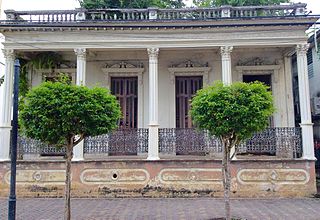
The Cardona Residence is a historic house in Aguadilla, Puerto Rico. It was built in 1913. It is "one of the most interesting and best preserved" houses in Aguadilla from its era.

Casa de Piedra, also known as Residencia Amparo Roldán, in Aguadilla, Puerto Rico, is a Spanish Colonial-style home that was erected in 1875. It is the only surviving residence of its era in Aguadilla; most similar ones were damaged in the 1918 San Fermín earthquake and eventually demolished.

El Parterre is a landscaped park in Aguadilla, Puerto Rico, that was built in 1851. The park encloses the Ojo de Agua, also referred to as Manantial Ojo de Agua, a natural spring which was a source of water for Spanish soldiers, and the source of a small rivulet locally called Chico River which empties into the Aguadilla Bay.

The Fuerte de la Concepción was a Spanish military fortress guarding the port and town of Aguadilla, Puerto Rico, in the 18th and 19th centuries. In 1986, the fort's single surviving building was listed on the U.S. National Register of Historic Places, and later on the Puerto Rico Register of Historic Sites and Zones in 2000.

Old Urban Cemetery, also known as Cementerio Municipal, in Aguadilla, Puerto Rico, is a cemetery with burials dating back to 1813 or 1814. Near the town of Aguadilla's north entrance, it spreads between the beach and the foot of the mountain and is enclosed by mortar and stone walls. It is located at the foot of Cuesta Vieja, a sector of Aguadilla barrio-pueblo. Many of its older tombs, made of brick, stone and mortar, were damaged in a 1918 earthquake.

The López Residence is a historic house in Aguadilla, Puerto Rico. Built in 1914, this one-story, Neoclassical structure is architecturally significant as a typical urban residence for a well-to-do Puerto Rican family in the early 20th century, and as one of the most important remaining works by architect Manuel Gómez Tejera. Notable architectural elements of the house include its five slender, octagonal Corinthian columns, recessed ceiling panels on the balcony, ornate cast-iron balcony ornamentation, native ceramic tile floors, rooftop balcony, four louvered wooden doors with scrollwork frames facing the street, and filigreed interior arches supported by turned and octagonal columns. It faces the 1925 District Courthouse across Progreso Street, forming a historic Neoclassical set.

Church San José of Aibonito, on the town plaza of Aibonito, Puerto Rico, was built over the ten-year period from 1887–1897. It was listed on the U.S. National Register of Historic Places in 1984, and on the Puerto Rico Register of Historic Sites and Zones in 2000.

Iglesia de San Carlos Borromeo is a historic church built in 1783, located on the main plaza of Aguadilla, Puerto Rico. It was listed on the U.S. National Register of Historic Places in 1984, and on the Puerto Rico Register of Historic Sites and Zones in 2000.
Farmacia Serra is a building close to the plaza of Bayamón, Puerto Rico which was built in 1910. It was listed on the National Register of Historic Places in 1989, and on the Puerto Rico Register of Historic Sites and Zones in 2000.

Paseo Víctor Rojas, also known as El Fuerte or Paseo de Damas, in Arecibo, Puerto Rico, was built in 1881. It was listed on the National Register of Historic Places in 1986, and on the Puerto Rico Register of Historic Sites and Zones in 2000.

The Casa Roig Museum is a historic house museum and gallery in Humacao, Puerto Rico. It was designed as a residence for the wealthy sugar planter Antonio Roig by the prominent Czech architect and Puerto Rico resident Antonin Nechodoma (1877–1928) and built in 1920.

Antiguo Casino Camuyano is a building in downtown Camuy, Puerto Rico, which dates from 1910. It was listed on the U.S. National Register of Historic Places in 1984 and on the Puerto Rico Register of Historic Sites and Zones in 2000.

The Iglesia de Nuestra Señora del Carmen is a church in Hatillo, Puerto Rico dating from 1879. It was listed on the National Register of Historic Places in 1984 and on the Puerto Rico Register of Historic Sites and Zones in 2000.

Edificio Oliver in Arecibo, Puerto Rico was built in 1914. The building houses government offices for the municipality of Arecibo.

Hacienda Santa Rita is located in the municipality of Guánica, Puerto Rico. It is also known as Casa Madre y Noviciado de las Hermanas Dominicas de Fatima and was built in 1800 by Don Mariano Quiñonez.

The José Celso Barbosa House Museum is a historic house museum in Bayamón municipality, Puerto Rico.

The La Liendre Bridge, spanning Beatriz Creek, a tributary to the Río de la Plata, between Cayey, Puerto Rico and Cidra, Puerto Rico. It was built in 1877 and was listed on the National Register of Historic Places in 1995, and on the Puerto Rico Register of Historic Sites and Zones in 2000.

The Church San José of Gurabo is a historic Catholic parish church located in Gurabo Pueblo in the municipality of Gurabo, Puerto Rico. The parish church is part of the Roman Catholic Diocese of Caguas.

Invención de la Santa Cruz is a historic Catholic parish church located in Bayamón Pueblo, the historic and administrative downtown area of Bayamón, Puerto Rico. The church is located on the Plaza de Hostos, the main town square of Bayamón, at 12 Degetau Street, in front of the former city hall and current Francisco Oller Museum building.

The Old District Courthouse of Humacao is a historic two-story concrete government building constructed in 1925 in the Neoclassical style located in Humacao Pueblo, in the Puerto Rican municipality of the same name. The building was designed by famed Puerto Rico State Architect Rafael Carmoega and built by the Public Buildings Division of the Department of Public Works.




















